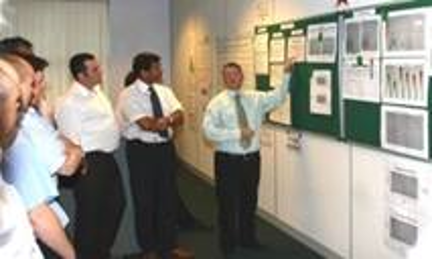With initial focus on applying Lean principles to manufacturing production, many tend to overlook the fact that Operational Excellence is an enterprise wide application…and that administrative and support service processes have a huge impact on overall organization performance.
Engaging in a Lean improvement program that addresses these services is essential. For one thing, it ensures gains achieved in your production operation aren’t off-set by inefficiencies in your admin operations. Plus, a well-led Lean ‘service’ effort uncovers and attacks an underestimated amount of waste which results in both increased customer service and employee satisfaction.
So why does Lean application in this environment prove so difficult?
Consider front end, or front office operations (those that directly affect customers, including sales, customer service, product development, and marketing), and back end, or business activities that serve as more of a support function (including IT, HR and inventory management)… all contribute to the overall customer experience and to a company’s performance, but unlike production, process wastes here are not as apparent.
Yet, as consumers, we are all acutely aware of the waste in front and back end operations; sadly, ‘TIM WOOD’ is alive and well in admin and service environments. The trick becomes learning to recognize what waste is in these environments. Consider these examples as you search for opportunities in your own organization:
- Transportation – movement of files or documents
- Inventory – orders waiting to be processed
- Motion – movement as a result of poor office flow
- Waiting – for information, people, equipment, approval
- Over Production – printing, filing documents that aren’t needed
- Over Processing – duplication of data collection and documentation
- Defects – failure demand, not getting things right the first time, rework, missing information
It can be surprising, but as much as 60% of activities in the service/admin environment can be considered waste…all the more reason we need to dig deeper to uncover and address them.
In services, Lean acts on two dimensions to eliminate “Silo Thinking” and improve the Customer Experience: first, it works to improve the end-to-end processes. Cross functional teams apply Lean methodologies to simplify and implement improvement ideas and build new ways of managing cross functional processes (value streams).

In addition, in each department, operational teams, working under their manager’s guidance, engage in continuous improvement of their work processes, making activities visible, creating visual flow management, managing their performance, and improving their operating standards. The result is a reduction of non-value-added work and the elimination of unnecessary work (i.e. Failure Demand).


Whether in end-to-end processes or within each department, an important key to improvement is to make work visible so waste can be easily identified. To accomplish this, it’s necessary to set-up a visual management system. A key component of a visual management system are visual boards that help manage activities like incoming demand flows, actual vs. projected performance (i.e. work backlogs), project milestones, workplace organization and execution standards. Visual boards help teams manage their daily/weekly activities against targets as they meet regularly to review ongoing projects.
But it is not enough just to place visual boards in the workplace. To be successful, a visual management system requires continual leadership commitment, engagement and support. It’s critical to establish leader routines to reinforce teams’ efforts. Here, it’s important to note that the role of leaders (at all company levels) shifts from that of problem-solver to one of support. Their new role is to keep improvement momentum going and ensure that everyone stays engaged. Leaders achieve this by coaching, teaching, recognizing milestones achieved, and creating a problem-solving mindset.
So many of the Lean methodologies can be successfully applied to service operations: value stream mapping, flow management, standard work, various problem-solving techniques, 5S, etc. but all efforts begin with making processes visible…because what can’t be seen can’t be improved.
Once visible, teams can attack built-in waste and achieve quick results. Here are a few improvements our Lean Management Certification for Services attendees achieved from their program projects:
- New product launch from 55 to 15 days
- Reduced invoice processing time from 22 to 8 hours
- Increased quotation capacity by 40%
- Reduced sales order through engineering design and pre-trial process from 5 days to 1
- Reduced IT support action item closure time by 25%
There’s improvement gold hiding in admin processes. Ask your production Lean or CI people to spend a day in accounting, sales or customer service departments. Have them map a process and ask employees about the pain points. The inherent waste and opportunities that exist for eliminating it will quickly become apparent.
You wouldn’t leave half your lawn unmowed, or clean only half your house. Why leave operational functions out of your Lean effort? Lean in admin and service environments will result in happier employees, happier customers, and a Leaner organization.
Not sure how to calcualte the benefits of bringing Lean to your admin processes? Give us a call. We’ll connect you with one of our Lean admin specialists who can help.
